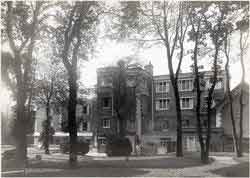
The formation of the hospital was due to the ever demanding needs for medical attention of the sick and wounded from the early stages of the great war and would be located as close to the fighting front as possible. The location at Neuilly was chosen because the existing structure The Villa Borghese at Neuilly-sur-Seine was already furnished as a large sanatorium with size, and access suitable to the needs of the facility.
The hospital was recognized as a homeopathic hospital and the therapeutics of practice was of the school of Hahnemann. Although the hospital did not serve as immediate trauma center the cases received were of an acute nature, with many requiring surgical procedures resulting from injuries, or complications.
Dr. Hawkes, of Liverpool was Chief of Medicine for some time, and documented many of the cases under his care. Among the eighty medical cases, ten of typhoid were treated, and none died. Chronic diseases of the alimentary canal there were eight. Cases of respiratory affliction amounted to forty. The remainder of medical cases were of heart disease, renal disease, and acute and chronic rheumatism.
The surgical cases Dr. Hawkes worked closely with Professor Hartmann (a world renowned Paris surgeon) in setting up a highly organized surgical installation. Surgical cases totaled one hundred and twenty-two, many fractures, and shrapnel fragments from the fighting lines. Although a complete listing of patients treated at Neuilly was located, specific information concerning each case was very limited.
The hospital was very much a peaceful place, with gardens, and grounds that were conducive for recuperative rest and healing. There was an air of well being, contentment, and peacefulness. The nurses were experts in their responsibilities, duties, and abilities. Patients were provided with the best care, to stimulate recovery, so as to return to their battle units as soon as possible.
The hospital closed in March 1916 due mainly to the enlistment of the majority of it’s doctors and nurses in the Royal Army Medical Corps.
While the Hospital at Neuilly was only open for a short time it played a key role in homeopathic treatment of the causalities from the Great War. The research could be interpreted that this was a restful, peaceful place that promoted healing from within one’s self through great attention to the personal needs of each patient by the entire staff, and their willingness to serve those in need.
References:
The Homeopathic Hospital at Neuilly, France 1914-1916
17th, April 1997 by Dr. M. Geoffrey Miller presented by Sylvain Cazalet
The Long, Long Trail Website produced by Chris Baker, 1996
About the author:
Jeff Niswonger is a Professional Life Wellness Coach, author, and speaker.
Helping clients to live and practice wellness, and personal development to enrich their lives.
Additional Information at author’s website: www.YourLifeYourDreams.com
Can be reached via email, [email protected]




